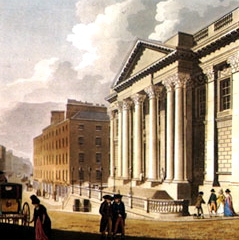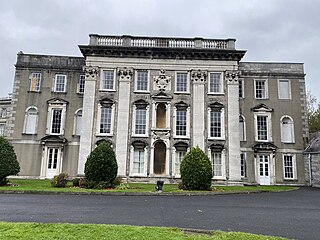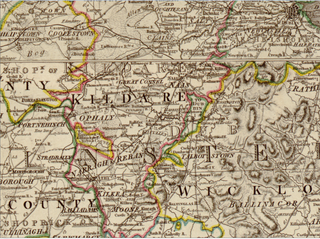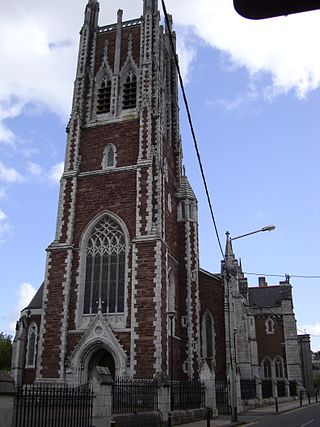Related Research Articles

Merrion Square is a Georgian garden square on the southside of Dublin city centre.

Henrietta Street is a Dublin street, to the north of Bolton Street on the north side of the city, first laid out and developed by Luke Gardiner during the 1720s. A very wide street relative to streets in other 18th-century cities, it includes a number of very large red-brick city palaces of Georgian design.
Sir Edward Lovett Pearce was an Irish architect, and the chief exponent of Palladianism in Ireland. He is thought to have initially studied as an architect under his father's first cousin, Sir John Vanbrugh. He is best known for the Irish Houses of Parliament in Dublin, and his work on Castletown House. The architectural concepts he employed on both civic and private buildings were to change the face of architecture in Ireland. He could be described as the father of Irish Palladian architecture and Georgian Dublin.

The Solicitor-General for Ireland was the holder of an Irish and then United Kingdom government office. The holder was a deputy to the Attorney-General for Ireland, and advised the Crown on Irish legal matters. On rare occasions, there was also a Deputy Attorney-General, who was distinct from the Solicitor-General. At least two holders of the office, Patrick Barnewall (1534–1550) and Sir Roger Wilbraham (1586-1603), played a leading role in Government, although in Barnewall's case, this may be partly because he, was also King's Serjeant. As with the Solicitor General for England and Wales, the Solicitor-General for Ireland was usually a barrister rather than a solicitor.
The Under-Secretary for Ireland was the permanent head of the British administration in Ireland prior to the establishment of the Irish Free State in 1922.

Dr Steevens' Hospital, one of Ireland's most distinguished eighteenth-century medical establishments, was located at Kilmainham in Dublin Ireland. It was founded under the terms of the will of Dr Richard Steevens, an eminent physician in Dublin. The seal of the hospital consisted of 'The Good Samaritan healing the wounds of the fallen traveller' with the motto beneath "Do Thou Likewise".
Events from the year 1743 in Ireland.

Mount Jerome Cemetery & Crematorium is situated in Harold's Cross on the south side of Dublin, Ireland. Since its foundation in 1836, it has witnessed over 300,000 burials. Originally an exclusively Protestant cemetery, Roman Catholics have also been buried there since the 1920s.
Events from the year 1771 in Ireland.

Thomas Cooley (1740–1784) was an English-born Irish architect who came to Dublin from London after winning a competition for the design of Dublin's Royal Exchange in 1768.

Sir William Robinson PC(I) was a British architect, military engineer and politician. He held several posts in the Dublin Castle administration, including as Surveyor General of Ireland from 1671 until 1700. He was an influential figure in the development of classical architecture in Ireland, designing many buildings in the English Baroque-style, particularly in Dublin.
Thomas Eyre ny, Ireland) was an Irish military engineer.
Arthur Jones-Nevill was an Irish politician. He served as Surveyor General of Ireland from 1743, and later as a Member of the Parliament of Ireland, although he lost both positions following allegations of maladministration and peculation. He later returned to Parliament, serving until his death.

Drumcondra House is a Georgian house and gardens in Drumcondra, Dublin, Ireland which as of 2022 forms part of the DCU All Hallows Campus and formerly part of All Hallows College. It was designed by the architects Sir Edward Lovett Pearce and Alessandro Galilei and was built in 1726 for Marmaduke Coghill who had originally lived in Belvidere House, and now forms part of DCU St. Patrick's Campus Drumcondra.

The High Sheriff of Kildare was the British Crown's judicial representative in County Kildare, Ireland from the 16th century until 1922, when the office was abolished in the new Free State and replaced by the office of Kildare County Sheriff. The High Sheriff had judicial, electoral, ceremonial and administrative functions and executed High Court Writs. In 1908, an Order in Council made the Lord Lieutenant the Sovereign's prime representative in a county and reduced the High Sheriff's precedence. However, the sheriff retained his responsibilities for the preservation of law and order in the county. The usual procedure for appointing the sheriff from 1660 onwards was that three persons were nominated at the beginning of each year from the county and the Lord Lieutenant then appointed his choice as High Sheriff for the remainder of the year. Often the other nominees were appointed as under-sheriffs. Sometimes a sheriff did not serve his full term due to death or another event, and another sheriff was then appointed for the remainder of the year. The dates given in this article are the dates of appointment.
The Sheriff of County Dublin was the Sovereign's judicial representative in County Dublin. Initially, an office for a lifetime, assigned by the Sovereign, the Sheriff became an annual appointment following the Provisions of Oxford in 1258. The first recorded Sheriff was Ralph Eure, appointed in that year. The next recorded Sheriff was Sir David de Offington, who was Sheriff in 1282. Besides his judicial importance, the sheriff had ceremonial and administrative functions and executed High Court Writs.

Sir John Benson ICE was an Irish architect, born in Collooney, County Sligo. Although most of his work was in Cork, he was knighted for his design for the Dublin Great Industrial Exhibition.
Thomas Molyneux, or Molinel (1531–1597) was a French-born English statesman, who held high office in Ireland during the Elizabethan era. He founded a dynasty which produced several distinguished members, and became the Molyneux baronets of Castle Dillon, County Armagh.
The Clerk of the Crown and Hanaper was a civil servant within the Irish Chancery in the Dublin Castle administration. His duties corresponded to the offices of Clerk of the Crown and Clerk of the Hanaper in the English Chancery. Latterly, the office's most important functions were to issue writs of election to the Westminster Parliament, both for the House of Commons and for Irish representative peers in the House of Lords.
Edward Joseph McParland is an Irish architectural historian and author. He was elected as Pro-Chancellor of University of Dublin, Trinity College in 2013, and continues to give lectures after his retirement in 2008. McParland is the co-founder of the Irish Architectural Archive which was established in 1976, and he has contributed extensively to architectural conservation in Ireland.
References
Sources
- McParland, Edward (1995). "The Office of the Surveyor General in Ireland in the Eighteenth Century". Architectural History. SAHGB. 38: 91–101. doi:10.2307/1568623. ISSN 0066-622X. JSTOR 1568623. S2CID 195025920.
Citations
- 1 2 McParland 1995
- ↑ Office of Public Works - About - History
- ↑ McParland 1995, p. 97
- 1 2 Dictionary of Irish Architects - Thomas Eyre
- 1 2 3 4 5 6 7 8 9 10 Hardinge, W. H.; Ridgeway, Thomas (1861–64). "On Mapped Surveys of Ireland". The Transactions of the Royal Irish Academy. 8: 39–55: 44. JSTOR 20488800 . Retrieved 9 September 2016.
- ↑ Ball, Francis Elrington (1903). "Merrion and its Castle". A History of the County Dublin: The People, Parishes and Antiquities from the Earliest Times to the Close of the Eighteenth Century. Vol. Part 2. Dublin: Alex. Thom. p. 10. Retrieved 10 September 2016.
his brother, Michael Fitzwilliam, of Donore, in the County Meath, Surveyor–General of the Crown lands
- ↑ Collins, Arthur; Brydges, Sir Egerton (1812). Collins's Peerage of England; Genealogical, Biographical, and Historical. F. C. and J. Rivington, Otridge and son. pp. 44–45. Retrieved 9 September 2016.
- 1 2 3 4 5 Hardinge, W. H. (1873). "On Manuscript Mapped and Other Townland Surveys in Ireland of a Public Character, Embracing the Gross, Civil, and Down Surveys, from 1640 to 1688". The Transactions of the Royal Irish Academy. 24, Antiquities: 3–118: 9. JSTOR 30079258 . Retrieved 9 September 2016.
- ↑ Hull, Charles Henry. The Economics Writings of Sir William Petty Together with the Observations Upon the Bills of Mortality. CUP Archive. p. xxiv.
- ↑ "Sir William Robinson (1645-1712)". Architects & Historical Figures. Archiseek.com. Retrieved 9 September 2016.
- ↑ Carroll, Patrick (2 October 2006). "Engineering the Data State: Scopes, Meters, and Graphs". Science, Culture, and Modern State Formation. University of California Press. p. 101. ISBN 9780520932807 . Retrieved 9 September 2016.
- ↑ Molyneux, Capel; Molyneux, William (1820). Phillipps, Thomas (ed.). An account of the family and descendants of Sir T. Molyneux, Kt, Chancellor of the Exchequer in Ireland. Evesham: Printed by J. Agg. p. 62. Retrieved 9 September 2016.
- ↑ Archiseek.com - Thomas Burgh (1670-1730)
- ↑ Dictionary of Irish Architects - Edward Lovett Pearce
- ↑ Dictionary of Irish Architects - Arthur Dobbs